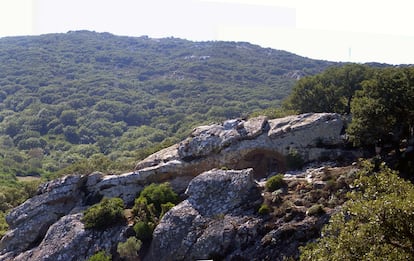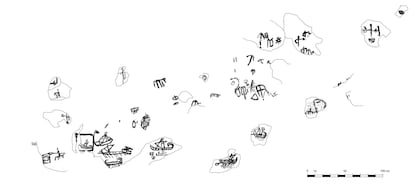The Ockham razor principle dictates that the most likely explanation is, to all accounts, the most truthful. So if some cave paintings, found in a holiday of Jimena de la Frontera (Cádiz), it turns out that they are all made with similar pigments, in an archaeological context coinciding with other deposits of the peninsula and the carbon test 14 confirms it, the Conclusion seems evident: they are between 4000 and 3000 before Christ. As much as those representations are seven sailboats and rowing that they have been bringing in the head to various researchers who have been trying to make sense half a century. So the finding, as obvious as it is strange, brings a milestone under the arm: those rounds of reddish strokes of Jimena’s high slab are the representations of older vessels in the Western Mediterranean.
It is just what a multidisciplinary team of researchers at the University of Granada in its article The prehistoric representations of the shelter of Laja Alta (Jimena de la Frontera, Cádiz). Disputes and scientific datapublished in the January issue of the scientific journal Pyrenae. “Given the data that there is no other. Ours is an evidence, the result of an investigation, ”explains the professor of the Department of Prehistory and Archeology of the UGR and coordinator of the research, with the hope of closing a scientific debate that has had comings and coming, since they appeared Those cave paintings in the 70s of the twentieth century, in the high slab of Jimen Gibraltar.
Many have been archaeologists who have tried to draw a plausible explanation what these seven ships – some with candles, others with oars – painted in red strokes on the stone with other schematic rock style figures, such as anthropomorphic figures or hidden idols ( with very schematic anthropomorphic features). There was a certain consensus in which it was a representation of the first meetings between indigenous and Phoenicians in the final bronze (from 1250 to 850 before Christ). It was in 2018 when Morgado and his team presented the carbon test 14 – realized on the black pigment sample of an ocule , but that did not root. However, again the controversy arose after the archaeologist Ana María Gomar Barea raised in 2022 that the drawings of the ships were paintings of medieval vessels, between the twelfth and fourteenth centuries, and very after the central schematic elements.
Morgado’s new study is based on all that previous controversy to criticize how all the analysis of the high slab have always been loaded, in their opinion, of “interpretive biases”, because they have supported themselves on stylistic studies focused only on ships , without taking into account the rest of the drawings. And, in contrast, the team composed of six researchers develops in detail the scientific data obtained with advanced techniques such as Fors spectroscopy, 3D digital models and absolute carbon dating 14 and thermoluminescence. All of them combined draw two key arguments: the Neolithic dating – thanks to that oculate black stroke performed on the red tones – and the interrelation of those central schematic motifs with the surrounding ships.
But what did some ships in the middle of the Strait of Gibraltar in full Neolithic? Although Morgado believes that an interpretive vein opens even to analyze, in his study he defends that they are not out of time. “These ships have bipod and tripod masts to assemble the lifting of the candle that already appear in the Egyptian world. It is also an archaizing naval architecture with counterparts in ships from IV to the II Millennium AC, ”says Morgado. As the study recalls, the oldest representations of vessels are found in the Petroglyphs of Gobustán-Azerbaijan-belonging to the mesolithic hunters-gatherers, while the first drawings of curved stern ships date from the IX-VIII millennia a. C., in the Caspian Sea area.

The vessels of the upper gaditana, with their candles and archaizing shapes, are inserted into that temporal line of the Euromediterranean field between the V and II Millennium a. C. without fuss. But they suppose a milestone for the area, since it places them as one of the oldest representations of the Western Mediterranean, without taking into account the engravings of the Cave of ásfendos, in Crete, due to the difficulty of the dating of the latter. However, Morgado does not attribute to the ships of Laja Alta a foreign character: “It would not presume that they are oriental, but can be indigenous because they are societies that demanded singular elements. I would bet that they are indigenous vessels, their own innovation, within their social complex. ”
In fact, the UGR archaeologist believes that it is time to abandon “colonialist already overcome” interpretations to address the knowledge of the southern residents of the Peninsula of the moment as more complex societies of what was believed in the past. “They are emerging societies open in some contacts with other populations,” says the researcher. Morgado supports its assertion in findings such as the myclenic ceramics fragments of the Llanete de los Moros de Montoro (Córdoba) dated in 2000 AC or the ivory workshop of Asian origin of Valencina (Sevilla) dated in the 3000 ac
“The connection vehicle was the sea. We had suspicions, but not evidence. They do not know prehistoric pecios, but we have elements to think that this society was in contact beyond the seas, ”dares to advance. Although that, according to the researcher, is no longer his task. “Now the next step of the interpretation remains. First we had to have the evidence, ”a proud ditch.

